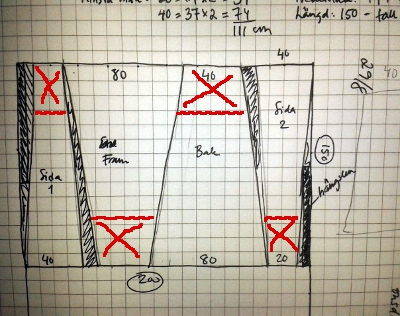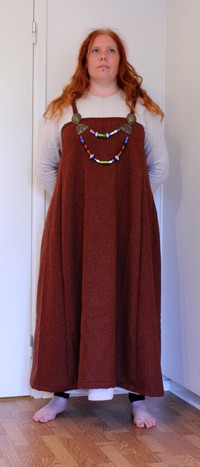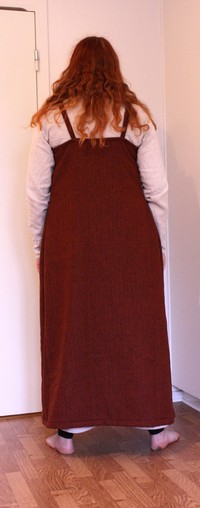Challenge #16 - Terminology
Kategori: , Allmänt
This was a challenge I thought I wouldn't do, actually. The terminology was the one found in the http://thedreamstress.com/research/the-great-historical-fashion-and-textile-glossary/ and I spent quite some time pondering what I could possibly do from it that fitted with my preferred timeperiods and planned projects. I never knew there were so many words for Persian lamb...!
Then Fate intervened in the form of a text from a friend who had got stuck in the middle of the planning of an apron dress, and then it was of course not a problem anymore since that word was actually in the list. I promptly kidnapped my friend's project.
I won't get into the discussion of how and if and why and when about apron dresses here, since Viking age is really not my era. I didn't delve too deep into the actual entry in the glossary for the same reason, but I decided to trust the Swedish History museum's helpful compilation of reasonably accurate basic patterns (the apron dress being part of a female outfit with the reservation of "burial dress not necessarily what people actuall wore" attached to it) and started sketching with the measurements the dress needed to fit and the amount of fabric we had.





The toughest part of this dress is to do something that fits nicely around the waist but that you can still get past shoulders and/or bust, and on second thought we both think this can do with a bit more pinning in front to get a more defined shape. Nothing that can't be done fairly easily, though, trial-and-error method. An underdress over the shift might be added later.

The pattern from the History Museum. A list if available patterns is found here http://www.alternaliv.se/histvarld/draekter/draekter.html

My own pattern. As you can see I don't mind the basic shaping at first, since the scraps won't be good for anything anyway one can just do the fitting on the actual garment instead (a lot better than realising that the waistline turned out to be 5 cm too low!). The fabric is 2m long and 1,5 wide and since we decided that 1 m was too little for lengt, we cut it on the width instead. The red crosses indicate fabric that was later cut away to make the dress shorter. I couldn't figure out a way to do it in a more fabric efficient way. On second thought, maybe four rectangular strips and 3 whole +2 half gores could have produced the shape more or less as well, but hey, I told you I decided to stick to the Museum version! The darker areas in upper left and bottom right corners are where scraps are to be used for the shoulder straps.
Fabric - a lovely black-and-red diamond twill - was cut and pinned and repinned, upper edge was hemmed by hand and the actual hem by machine. The result looks like this at the moment (with bling attached):



The toughest part of this dress is to do something that fits nicely around the waist but that you can still get past shoulders and/or bust, and on second thought we both think this can do with a bit more pinning in front to get a more defined shape. Nothing that can't be done fairly easily, though, trial-and-error method. An underdress over the shift might be added later.
The Challenge: 16, terminology
Fabric: Red and black diamond twill wool
Pattern: Drafted from the Historic museum one
Year: 10th century AD
Notions: Polyester and linen thread
How historically accurate is it? Hard to say, since there seems to be a lot of debate going on. Also, it's mostly machine sewn. 50%?
Hours to complete: 5,5 + 15 minutes for pattern draft. Early period and sewing machines have their uses!
First worn: Will be worn 23rd of August.
Total cost: Friend says fabric was about 27 euros/m, so I guess about perhaps 58-60 euros including thread bought for the occasion.
Fabric: Red and black diamond twill wool
Pattern: Drafted from the Historic museum one
Year: 10th century AD
Notions: Polyester and linen thread
How historically accurate is it? Hard to say, since there seems to be a lot of debate going on. Also, it's mostly machine sewn. 50%?
Hours to complete: 5,5 + 15 minutes for pattern draft. Early period and sewing machines have their uses!
First worn: Will be worn 23rd of August.
Total cost: Friend says fabric was about 27 euros/m, so I guess about perhaps 58-60 euros including thread bought for the occasion.
Might be updated with more and better pictures later, possibly after some adjustments are made.

